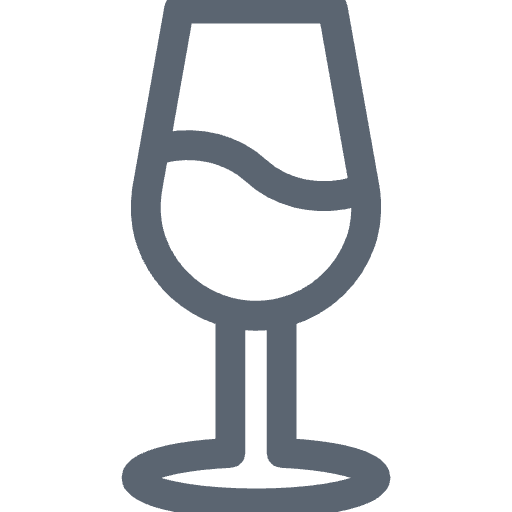General information about Barolo
During harvest time in Piedmont , the hills are often shrouded in mist. Rows of copper and gold vines emerge from the lower slopes, some still devoted to hazelnut cultivation. It is a magical experience to visit the region, feast on truffles, and admire the dark Nebbiolo grapes through the mist. The Barolo growing area covers around 1,800 hectares. It lies southwest of Alba and includes eleven villages. The vineyards are located at altitudes between 200 and 540 meters. Nowhere else in Italy (or in the world) does the Nebbiolo grape produce such complex, profound, and distinctive wines as there: powerful and tannic on the one hand, yet delicate and aromatically subtle on the other. A good Barolo is perhaps the most uncompromising wine of all, revealing its true appeal, its ethereal bouquet, only after decades of bottle aging.
Barolo grape variety
A Barolo must be made from a single varietal of Nebbiolo . It may only be released after three years, and at least 18 of those months must be spent in wooden barrels—an indication that it requires aging. A Barolo from top vineyards, however, also has enormous potential for refinement and will age for several decades.
The terroir in Barolo
The soils are of maritime origin and contain a lot of limestone marl and clay. In the eastern part (Serralunga, Monforte d'Alba, Castiglione Falletto), they date back to the Helvetian period and are geologically older. The Barolo wines from this region are the longest-lasting and most tannic. In the western part, the Barolo is more fragrant and somewhat leaner. In the municipality of Barolo itself, the two soil types overlap. Barolo has always been at the top of the list of the most avid wine collectors, with predictable effects on the price of both wine and vineyard land.
To the south and west of the Alba road around La Morra, the calcareous marl soils resemble those of Barbaresco. La Morra is by far the largest municipality, with elevations ranging from 200 to 500 meters, making it impossible to generalize about the wine styles, although Rocche dell'Annunziata is recognized as the best site. The municipality of Barolo tends to produce somewhat less energizing, more open-flavored wines. The major vineyards here are Brunate, Cerequio, and the famous Cannubi.
Towards the east, in the vineyards of Castiglione Falletto, Serralunga d'Alba, and those to the north of Monforte d'Alba, the soils are sandstone-based and much less fertile. They tend to produce even more concentrated wines that require extremely long aging periods. Serralunga d'Alba is home to the revered Cru Francia, owned exclusively by Giacomo Conterno, as well as the former royal estate of Fontanafredda, a connection that helped develop Barolo's status as "the wine of kings, the king of wines."
FAQ about Barolo wines
What is the name of the grape variety of the Italian red wine Barolo?
The main grape variety of the Italian red wine Barolo is Nebbiolo.
What kind of wine is Barolo?
Barolo is a high-quality, dry red wine from the Piedmont region of northern Italy. It is often considered one of the finest Italian wines.
What color is Barolo?
Barolo is a red wine that has a deep red to brick red color.
How much does Barolo wine cost?
The cost of Barolo wine can vary greatly depending on factors such as the vintage, wine quality, and producer. Typically, prices start at around €30 per bottle and can range up to several hundred euros.
Where does Barolo wine grow?
Barolo wine is grown in the Langhe region in the province of Cuneo, Piedmont, Italy.
Is Barolo a good red wine?
Yes, Barolo is considered one of the finest Italian red wines and has an excellent reputation for its complexity, structure and aging potential.
Is Barolo a dry wine?
Yes, Barolo is a dry red wine. It often has a robust tannin structure, which contributes to its aging potential.
Is Barolo a heavy wine?
Yes, Barolo is often described as a heavy wine because it is powerful, tannic and full-bodied.
Which is the best Barolo wine?
It's difficult to determine a single "best" Barolo, as this depends heavily on personal preference and vintages. Famous Barolo producers such as Giacomo Conterno, Bruno Giacosa, and Gaja offer some of the highly rated wines.

 Piedmont
Piedmont  Nebbiolo, dry
Nebbiolo, dry fragrant & elegant
fragrant & elegant

 Piedmont
Piedmont  Nebbiolo, dry
Nebbiolo, dry ethereal & complex
ethereal & complex

 Piedmont
Piedmont  Nebbiolo, dry
Nebbiolo, dry ethereal & complex
ethereal & complex

 Piedmont
Piedmont  Nebbiolo, dry
Nebbiolo, dry fruity, spicy, cool
fruity, spicy, cool

 Piedmont
Piedmont  Nebbiolo, dry
Nebbiolo, dry fruity, spicy, cool
fruity, spicy, cool

 Piedmont
Piedmont  Nebbiolo, dry
Nebbiolo, dry complex & concentrated
complex & concentrated

 Piedmont
Piedmont  Nebbiolo, dry
Nebbiolo, dry complex & concentrated
complex & concentrated

 Piedmont
Piedmont  Nebbiolo, dry
Nebbiolo, dry complex & concentrated
complex & concentrated










